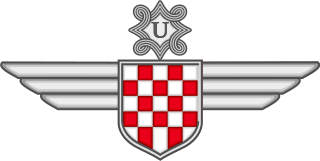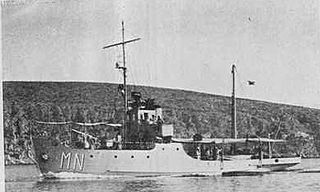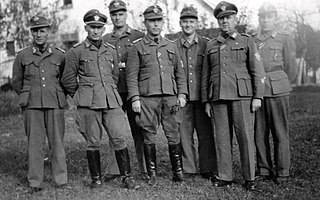
The Navy of the Independent State of Croatia, was the navy of the Independent State of Croatia, an Axis puppet state controlled by the fascist Ustaše party. The NDH was created from parts of the Kingdom of Yugoslavia on 10 April 1941, four days after the World War II invasion of Yugoslavia by the Axis powers commenced. The RMNDH consisted of two commands, the Coast and Maritime Traffic Command, and the River and River Traffic Command, and had its headquarters in the NDH capital, Zagreb. The Coast and Maritime Traffic Command consisted of three naval commands along the Adriatic coast, which were each divided into a number of naval districts. The naval districts consisted mainly of naval and weather stations, and were only responsible for coast guard and customs duties. The River and River Traffic Command consisted of seven river stations, a naval infantry battalion, and a River Command Flotilla built around two former Yugoslav river monitors, which had been scuttled during the invasion but subsequently refloated.
Vorpostenboot, also referred to as VP-Boats, flakships or outpost boats, were German patrol boats which served during both World Wars. They were used around coastal areas and in coastal operations, and were tasked with – among other things – coastal patrol, ship escort, and naval combat.
The Black Sea Campaigns were the operations of the Axis and Soviet naval forces in the Black Sea and its coastal regions during World War II between 1941 and 1944, including in support of the land forces.

The Croatian Air Force Legion, or HZL, was a unit of the Luftwaffe, composed entirely of volunteers drawn from the nazi puppet-state, the Independent State of Croatia. Many of them had previously served in the Royal Yugoslav Air Force in April 1941 during the Nazi Invasion of Yugoslavia.

The Royal Navy, commonly known as the Royal Yugoslav Navy, was the naval warfare service branch of the Kingdom of Yugoslavia. It was brought into existence in 1921, and initially consisted of a few former Austro-Hungarian Navy vessels surrendered at the conclusion of World War I and transferred to the new nation state under the terms of the Treaty of Saint-Germain-en-Laye. The only modern sea-going warships transferred to the new state were twelve steam-powered torpedo boats, although it did receive four capable river monitors for use on the Danube and other large rivers. Significant new acquisitions began in 1926 with a former German light cruiser, followed by the commissioning of two motor torpedo boats (MTBs) and a small submarine flotilla over the next few years. When the name of the state was changed to Yugoslavia in 1929, the name of its navy was changed to reflect this. In the late 1920s, several of the original vessels were discarded.

The Adriatic campaign of World War II was a minor naval campaign fought during World War II between the Greek, Yugoslavian and Italian navies, the Kriegsmarine, and the Mediterranean squadrons of the United Kingdom, France, and the Yugoslav Partisan naval forces. Considered a somewhat insignificant part of the naval warfare in World War II, it nonetheless saw interesting developments, given the specificity of the Dalmatian coastline.
30th U-boat Flotilla of Nazi Germany's Kriegsmarine was formed in October 1942. Six U-boats reached the Black Sea after a transport over land and canals and operated from the harbours of Constanţa and Feodosiya from 1942 to 1944.
Edgar Angeli was a Croatian rear admiral who served as the commander of the Navy of the Independent State of Croatia between 1943 and 1944.

The Azov Flotilla or Azov Naval Flotilla was the name given to several Russian naval forces operated on the Sea of Azov as part of the Imperial Russian Navy, by both the Soviets and the White Russians during the Russian Civil War, and as part of the Soviet Navy during World War II.

Arctic naval operations of World War II were the World War II naval operations that took place in the Arctic Ocean, and can be considered part of the Battle of the Atlantic and/or of the European Theatre of World War II.
The action of 13 May 1942 was a naval engagement during World War II between the British Royal Navy and the German Kriegsmarine. It was an attempt by Royal Navy Motor Torpedo Boats (MTBs) to stop the German auxiliary cruiser Stier from reaching Gironde, France. Stier made it through the English Channel and reached Gironde, but MTBs sunk the German fleet torpedo boats Iltis and Seeadler. MTB 220 was sunk by the German ships.
The action of 1 November 1944, also known as the Ambush off Pag Island, was a naval engagement in the Kvarner Gulf of the Adriatic Sea, between the islands of Pag and Lussino on 1 November 1944. It was fought between a British Royal Navy destroyer flotilla and a Kriegsmarine force of two corvettes and a destroyer. The German flotilla was deployed to escort a convoy retreating from Šibenik to Fiume. The British managed to destroy all three German ships in return for no loss.

The Battle of Ist was a naval engagement in Adriatic Sea, between the islands of Škarda and Molat, off the island of Ist, on 29 February 1944. The engagement was fought between two Free French Naval Forces destroyers and a Kriegsmarine force of two corvettes, two torpedo boats and three minesweepers. The German flotilla had been deployed to escort a freighter. In the ensuing engagement the French managed to destroy the German freighter and a corvette in return for no loss before withdrawing.

The Albona class were mine warfare ships used by the Italian Regia Marina and Royal Yugoslav Navy. Fourteen ships were originally laid down between 1917 and 1918 for the Austro-Hungarian Navy as the MT.130 class. However, the end of World War I and the dissolution of Austria-Hungary left them incomplete until 1920, when three ships were finished for the Regia Marina. These ships were armed with two 76 mm (3 in) guns. An additional five ships were completed for the KM in 1931 as the Malinska or Marjan class, and were armed with a single 66 mm (2.6 in). All of the completed ships could carry 24 to 39 naval mines. The remaining ships were never completed.

The Schichau class consisted of 22 torpedo boats built for the Austro-Hungarian Navy between 1885 and 1891. The class was one of the first torpedo boat classes built for the Austro-Hungarian Navy, and they were initially powered by steam from a single locomotive boiler and were armed with two 37 mm (1.5 in) Hotchkiss guns and two 356 mm (14 in) torpedo tubes. The entire class was reconstructed between 1900 and 1910, when they received two Yarrow boilers and a second funnel.

Surface flotillas of the Kriegsmarine were organizational groupings of German naval vessels during World War II based on class of vessel and geographical location. Surface flotillas were not operationally deployed units, but functioned through the administrative command chain of the Kriegsmarine.
The Ranks of the Independent State of Croatia Armed Forces are the ranks used by the Independent State of Croatia, it had similar insignia to those of the Armed Forces of Nazi Germany.

The German-Croatian Police, also known as the German-Croatian SS Police and Gendarmerie, was a force established by the SS for internal security operations in the Independent State of Croatia. In all, 32,000 Croats served in the various units of this Police force, under German command, with the task of preserving order and help defend Axis strategic positions throughout the country.

Fritz Neidholdt was a German Wehrmacht general during World War II. Neidholdt was best known from 1942 to 1944 as commander of the 369th (Croatian) Infantry Division, a unit composed of Croatian personnel with German cadres, notorious for its brutality and nicknamed the Devil's Division. Neidholdt was extradited to Yugoslavia in 1947 where he was convicted as a war criminal, sentenced to death and executed.

The Quarta Flottiglia MAS was an Italian flotilla of the Regia Marina created during the Fascist regime.













